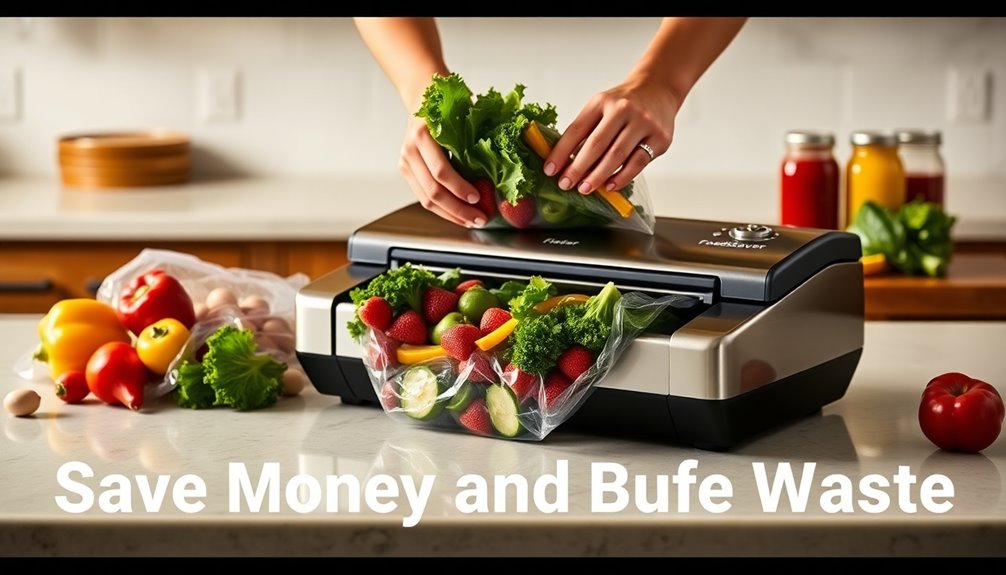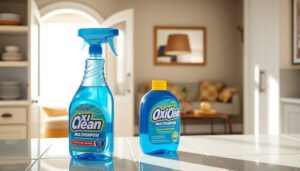Using a Foodsaver is an excellent way to save money by preserving your food for longer. It helps cut down on waste and keeps your groceries fresh. Seal bread to extend its life by up to three months, while meat can last two to three years. Don't forget to vacuum seal dry goods and beans to maintain their quality. Portion control becomes easy with this method, making meal prep simple and efficient. Finally, labeling your bags guarantees you know what you have, reducing spoilage. Stick around, and you'll uncover more tips to maximize your Foodsaver's benefits!
Reduce Food Waste
Reducing food waste is essential for both your wallet and the environment. Did you know that Americans waste about 25% of the food they buy each year? That's a staggering cost of over $1,500 annually for spoiled food alone!
One effective method to combat this waste is through vacuum sealing. By using vacuum sealing techniques, you can extend the shelf life of your groceries by weeks or even months, considerably lowering the chances of spoilage. Additionally, utilizing coupon codes when purchasing vacuum sealers or storage bags can enhance your savings on these products. Moreover, employing budgeting apps can help you track your grocery expenses more efficiently.
When you vacuum seal bulk purchases, you're not just saving money; you're also preventing waste. Foods stay fresh and usable much longer than with traditional storage methods. In fact, studies show that vacuum sealing can help reduce 24% of the landfill waste caused by food spoilage, making your food management practices more sustainable. Additionally, adopting similar practices to those found in expense management apps can help you track your grocery spending more effectively.
Furthermore, vacuum sealing allows for better meal planning and portion control. You can pack meals in appropriate sizes, ensuring you only prepare what you need. This helps you manage your household food consumption more efficiently.
Embracing vacuum sealing as a regular practice can lead to substantial savings and a healthier planet.
Extend Bread Shelf Life
Vacuum sealing isn't just about saving leftovers; it's also a game-changer for extending the shelf life of bread. By vacuum sealing your bread, you can extend its freshness by up to three months compared to traditional storage methods. This process prevents mold and staleness, guaranteeing you always have tasty bread on hand. Additionally, using expense tracking tools can help entrepreneurs save money, which can be reinvested in quality ingredients for baking. Budget apps can also assist in effective management of your finances, ensuring you allocate funds wisely.
One of the best practices is to freeze vacuum-sealed bread. This not only maintains its freshness but also makes meal prep a breeze. Forget those last-minute grocery runs; you can quickly pull out a loaf or sandwich rolls whenever you need them.
Plus, vacuum-sealed pastries, cookies, and cakes can also be preserved for longer, retaining their delightful taste and texture while minimizing food waste. By utilizing sustainable practices for food storage, you can also contribute to reducing waste in your kitchen.
When sealing your bread, make certain to remove as much air as possible. This step is vital to prevent freezer burn and guarantee peak preservation.
Properly vacuum-sealed and frozen bread can be thawed overnight in the fridge, providing easy access to fresh bread whenever you're craving it. With these tips, you'll enjoy longer-lasting bread and delicious baked goods without the worry of spoilage.
Increase Meat Shelf Life
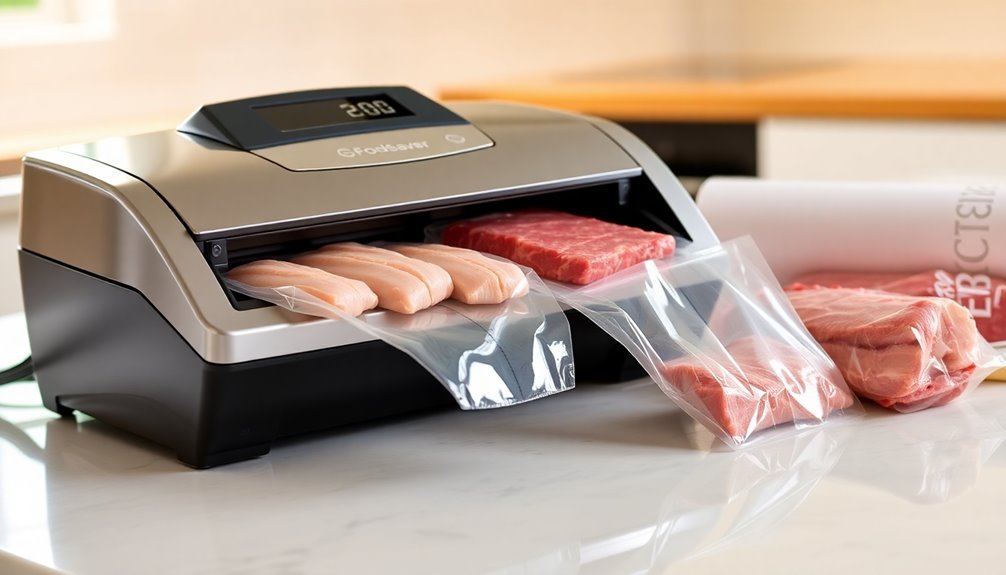
Sealing fresh cuts of meat can greatly boost their shelf life, keeping them fresh for up to 3-5 times longer than traditional storage methods. By vacuum sealing, you prevent spoilage and freezer burn, which are common issues with regular storage. This method effectively removes air, limiting oxidation and markedly slowing bacterial growth, so you can feel confident about the safety and quality of your meat. Additionally, using tools like automated investment management can help you optimize your financial resources for purchasing high-quality food products.
If you like to marinate your meat, consider doing it in a vacuum-sealed bag. Not only does this enhance flavor, but it also tenderizes the meat while prolonging its freshness. Additionally, using AI-driven tools for optimizing product discovery can help you find the best vacuum sealers tailored to your needs.
When you store vacuum-sealed meat in the freezer, it can maintain its quality for up to two to three years, allowing you to buy in bulk without worrying about waste.
Properly vacuum-sealed meats retain their taste, texture, and nutritional value, ensuring your meals are just as enjoyable as when they were first prepared.
Safe Storage for Dry Goods
When it comes to storing dry goods, vacuum sealing is your best friend. It not only keeps your essentials fresh longer but also prevents contamination risks from pests and moisture. Additionally, timely payments can help you budget for purchasing high-quality food storage solutions that enhance your food preservation efforts. Implementing automated notifications can also ensure you never miss a payment, allowing you to invest in the best storage options consistently. Furthermore, clear payment terms can help you understand your financial commitments, ensuring you have the means to continually stock up on essential items.
Vacuum Seal Essentials
To keep your dry goods fresh and flavorful, using a vacuum sealer is a game changer. By vacuum sealing items like flour, rice, and nuts, you can greatly extend their shelf life, preserving freshness and preventing spoilage for up to six months or longer. This method removes air and moisture, protecting your dry goods from oxidation while ensuring they retain their taste, texture, and nutritional value.
When you use vacuum seal bags, you can easily label them with dates and contents, allowing for better organization in your pantry. This not only helps manage your inventory but also reduces the likelihood of waste.
If you often buy dry goods in bulk, vacuum sealing can save you money as it lets you purchase larger quantities at lower prices while preventing spoilage.
Moreover, vacuum sealing maintains the crunchiness and flavor of your snacks and baking ingredients, making it an effective preservation method.
Prevent Contamination Risks
By vacuum sealing your dry goods, you can greatly reduce the risks of contamination and spoilage. This method protects your food from moisture, pests, and bacteria, extending shelf life considerably.
Here are some key practices to help you prevent contamination risks:
- Choose the Right Vacuum Sealer: When looking for a vacuum sealer to buy, pick one that offers reliable performance and durability.
- Seal Immediately: As soon as you open a bag of flour or rice, seal it up to minimize exposure to air and moisture.
- Use Airtight Containers: For added protection, consider using vacuum-sealed containers for items like sugar and grains. This reduces cross-contamination with other pantry items.
- Label and Date: Always label your vacuum-sealed packages with the contents and date sealed. This guarantees you use the oldest items first and maintain freshness.
Maintain Freshness Longer
Maintaining freshness with vacuum-sealed dry goods is a game changer for your pantry. By vacuum sealing items like flour, rice, and nuts, you can extend their shelf life considerably. This method prevents moisture exposure, keeping texture and flavor intact for months longer than traditional storage.
Imagine not having to toss out stale snacks! Studies show that vacuum-sealed chips and trail mixes stay fresh and crunchy up to five times longer than those stored in standard packaging.
Additionally, vacuum sealing effectively protects your dry goods from pests and contaminants, drastically reducing spoilage and waste. With this technique, you can buy in bulk, saving money while ensuring your items remain usable for extended periods.
In fact, using vacuum-sealed bags can help you save an estimated $1,300 annually on spoiled food.
To find out which vacuum sealer suits your needs best, take a vacuum sealer quiz online. This quick assessment can guide you in choosing the right model for maintaining the freshness of your pantry staples.
Start vacuum sealing today and watch your food last longer and your savings grow!
Vacuum Seal Your Beans
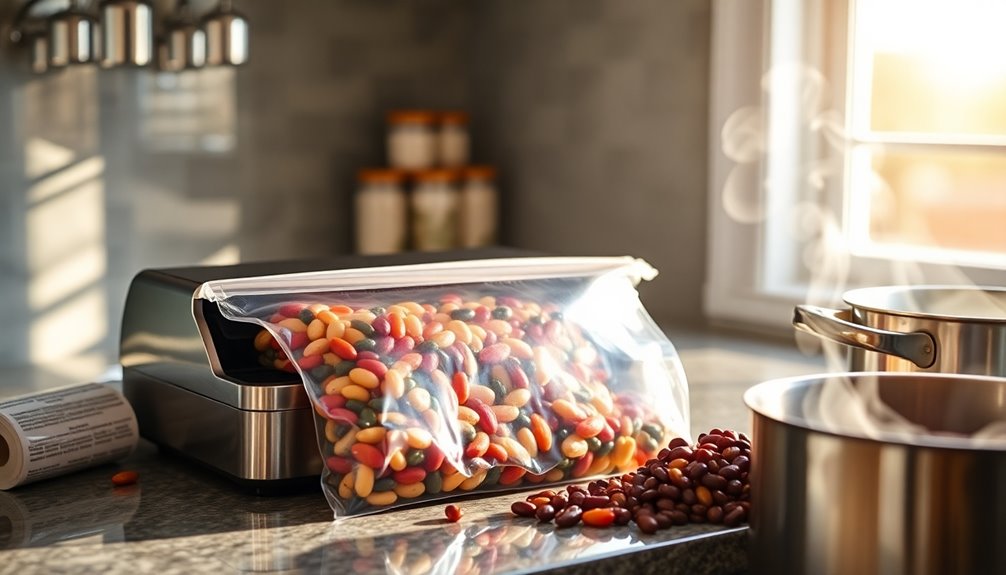
Vacuum sealing your beans can greatly extend their shelf life, keeping them fresh for up to six months without spoilage.
By using a vacuum sealer, you can store beans in larger quantities, saving money on your grocery bills. Properly sealed beans retain their flavor and nutrients, making your meals both enjoyable and nutritious. This method not only preserves food but also aligns with efficient monitoring of your food storage strategies. Additionally, utilizing automated expense tracking tools for your grocery purchases can further enhance your budgeting efforts.
Here's how to effectively vacuum seal your beans:
- Choose Fresh Beans: Select high-quality, dry beans to guarantee the best flavor and longevity.
- Pre-Cook (Optional): If you want convenience, consider cooking the beans before sealing. It saves time when you're ready to use them.
- Use a Vacuum Sealer: Place the beans in vacuum-sealable bags, making sure you leave enough space for sealing.
- Label and Store: After sealing, label the bags with the date and type of beans. Store them in a cool, dark place for maximum freshness.
Not only does vacuum sealing help reduce food waste by preventing beans from going stale, but it also makes meal preparation quick and easy. Using this method aligns with tracking performance metrics to ensure that you are optimizing your food storage strategies.
Just thaw vacuum-sealed beans overnight in the fridge, and you're ready to cook!
Preserve Homemade Sauces
After you've successfully vacuum sealed your beans, consider preserving your homemade sauces the same way. Vacuum sealing can extend their shelf life considerably, keeping them fresh for up to 12 months in the freezer.
In contrast, sauces usually last just a few days in the refrigerator. By using a vacuum sealer to remove air and seal your sauces in bags, you'll prevent oxidation and bacterial growth, maintaining their flavor and nutritional quality. Additionally, this method aligns with the benefits of using digital coupons for groceries, allowing you to save money while reducing food waste.
Batch cooking sauces and vacuum sealing them allows for easy meal prep. You'll always have homemade options on hand for quick meals, eliminating the need to cook from scratch each time.
Plus, vacuum-sealed sauces can be reheated directly in the bag, making it a convenient option for busy schedules, minimizing mess while retaining the original taste.
Don't forget to label your vacuum-sealed sauce bags with dates and contents to help keep your freezer organized. This way, you'll know what you have available and guarantee you use them before they lose quality.
With these tips, you can enjoy your homemade sauces longer and make mealtime easier!
Save on Meal Preps

When you use a Foodsaver for meal prep, you'll find it easier to control portions and stick to your dietary goals.
Batch cooking and vacuum sealing not only save you time during busy weekdays but also make reheating a breeze.
Plus, you'll enjoy meals that taste fresh and delicious without the worry of freezer burn.
Efficient Portion Control
Mastering efficient portion control is a game changer for meal prepping, allowing you to manage your food more effectively and reduce waste.
By using a Foodsaver, you can seal meals in individual portions, which helps you only defrost what you need. This method can keep your meals fresh for up to five times longer than traditional storage, saving you money on groceries.
Here are some tips for effective portion control:
- Plan Your Meals: Decide on your weekly menu to determine portion sizes that fit your dietary needs.
- Use Vacuum-Sealed Bags: Divide bulk ingredients into manageable portions, minimizing spoilage and food waste.
- Label Your Portions: Clearly mark each bag with contents and date, so you can easily grab what you need.
- Practice Mindful Eating: Stick to the sealed portions to promote healthier serving sizes and avoid overeating.
Quick Reheating Solutions
Quick reheating solutions can greatly streamline your meal prep routine, making it easier to enjoy delicious, home-cooked meals without the hassle. When you vacuum-seal your meals using a FoodSaver, you can reheat them directly from the freezer. This saves you time and eliminates the need for additional cooking, allowing you to enjoy your meals quickly.
By portioning out your meals, you not only minimize waste but also create an efficient way to grab and reheat a meal as needed. Vacuum-sealed meals can last 3-5 times longer in the freezer, ensuring they maintain their quality, taste, and nutrients when reheated.
You can easily reheat these meals in the microwave or sous vide, keeping food waste low and saving money on groceries. Preparing larger batches becomes more practical since you won't have to worry about spoilage.
Additionally, by using these quick reheating solutions, you can avoid multiple grocery trips, cutting down on transportation costs and reducing the likelihood of impulse purchases. With these strategies, meal prep becomes not just easier but also more economical.
Batch Cooking Benefits
Batch cooking offers a practical solution for those looking to save time and energy during the week. By preparing multiple meals at once, you can markedly cut down on cooking time and energy costs.
Here's how batch cooking with a vacuum sealer can benefit you:
- Extended Shelf Life: Vacuum sealing your batch-cooked meals can prolong their freshness by 3-5 times, helping you avoid food spoilage and waste.
- Portion Control: By portioning meals before sealing, you can maintain serving sizes, promoting mindful eating and reducing the chances of overconsumption.
- Cost Efficiency: Purchasing ingredients in bulk for batch cooking allows you to save money, minimizing the need for frequent grocery trips and maximizing your food budget.
- Convenience: Using a Foodsaver for meal preps gives you quick, ready-to-eat options, encouraging healthier eating habits without the hassle of daily cooking.
With these advantages, batch cooking not only saves you time and energy but also helps you save money while enjoying delicious, nutritious meals throughout the week.
Embrace this method and watch how it transforms your meal prep routine!
Organize Food in Portions
Organizing food into portions is a game changer for meal planning and reducing waste. When you divide your food into vacuum-sealed portions, you guarantee that you only thaw and cook what you need. This not only helps with better meal management but also encourages you to adopt healthier eating habits by preventing overeating.
By vacuum sealing, you can achieve precise portion control, making it easier to maintain mindful consumption. Plus, organizing food in vacuum-sealed portions maximizes your freezer space. You can stack bags neatly and store them flat, optimizing your storage efficiency.
Don't forget to label each vacuum-sealed portion with dates and contents. This aids in keeping your pantry organized and guarantees you use older items first, minimizing spoilage.
Using vacuum-sealed portions allows you to buy in bulk, which can lead to significant cost savings. Since the quality of your food is preserved, you reduce the frequency of grocery shopping trips, making it easier on your wallet.
Embrace the benefits of organizing food in vacuum-sealed portions, and watch your meal planning and waste reduction improve immensely!
Shop Less for Savings
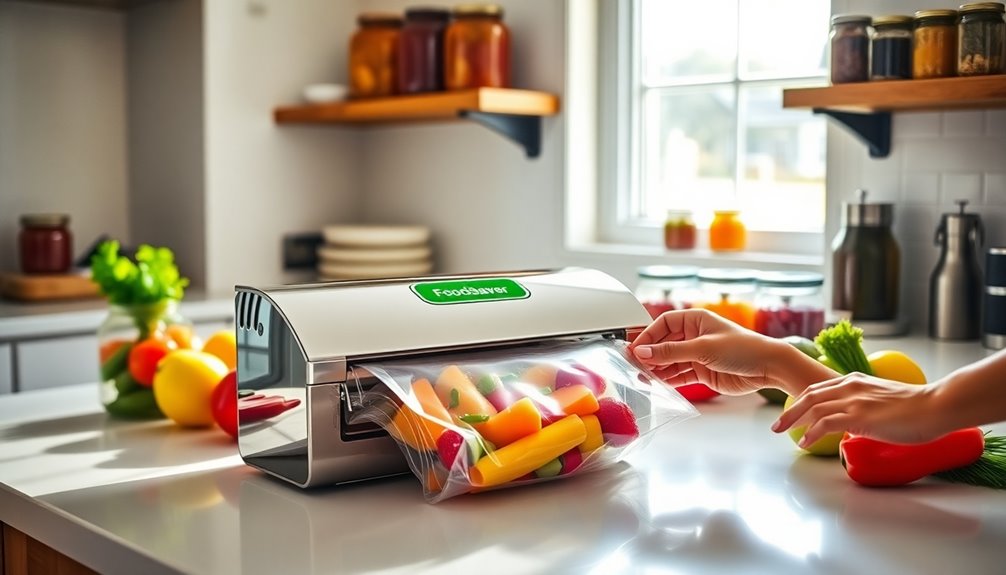
By vacuum sealing your bulk purchases, you can cut your grocery trips in half and save money on gas and impulse buys.
This method not only extends the shelf life of your food but also encourages cost-effective meal planning, helping you avoid overbuying.
With these strategies, you'll find your grocery bills dropping markedly while enjoying fresher ingredients.
Bulk Purchasing Benefits
Often, savvy shoppers find that bulk purchasing can lead to significant savings on their grocery bills.
By using a FoodSaver, you can enjoy the numerous bulk purchasing benefits while minimizing waste.
Here's how you can maximize your savings:
- Cost Savings: Buying in bulk can save you up to 30% compared to individual purchases.
- Extended Shelf Life: Vacuum sealing extends the shelf life of perishables by 3-5 times, reducing spoilage.
- Quality Maintenance: Vacuum-sealed foods retain their freshness, allowing you to enjoy seasonal items long after purchase.
- Waste Reduction: Families using vacuum sealing save an average of $1,300 annually by minimizing food waste.
Reduced Grocery Trips
With a FoodSaver in your kitchen, you can greatly reduce the number of grocery trips you make. By vacuum sealing, you can buy in bulk and take advantage of sales on larger quantities, minimizing those frequent trips to the store. This not only saves time but also helps you save money in the long run.
Vacuum sealing extends the shelf life of perishable items like meats and vegetables, so you won't need to rush out for replacements. Studies show that Americans waste about $1,300 a year on spoiled food, but with a FoodSaver, you can preserve your food for weeks or even months, cutting down on unnecessary grocery visits.
Utilizing vacuum-sealed bags for meal prep means you can prepare multiple meals at once. This way, you have ready-to-eat options available, further decreasing the need for regular grocery shopping.
Plus, when you vacuum seal dry goods and snacks, you maintain their freshness for longer, which reduces the frequency of replacing these items. Ultimately, these strategies lead to significant savings and fewer trips to the grocery store, allowing you to spend more time enjoying your meals rather than shopping for them.
Cost-Effective Meal Planning
Cost-effective meal planning can transform your grocery shopping habits, helping you save both time and money.
By incorporating vacuum sealers into your routine, you'll reduce waste and lower costs markedly. Here's how to get started:
- Plan Your Meals: Create a weekly menu based on seasonal items. This not only saves money but guarantees freshness.
- Buy in Bulk: Purchase larger quantities of non-perishables or seasonal produce. Vacuum sealing these items extends their shelf life and locks in freshness.
- Portion Control: Divide meals into individual portions before vacuum sealing. This encourages mindful eating and prevents overeating, keeping you on budget.
- Limit Shopping Trips: With a well-thought-out meal plan, you can minimize grocery trips. This cuts down on transportation costs and reduces impulse buys.
Prevent Freezer Burn
To prevent freezer burn, it's essential to create an airtight seal around your food. Using a vacuum sealer allows you to accomplish this by removing the air and moisture that cause freezer burn.
When food is vacuum-sealed, it retains its original quality for up to five times longer compared to traditional packaging. This means you can store bulk purchases without worrying about spoilage.
Freezer burn occurs when moisture evaporates from food, leading to dry spots and a loss of texture. By using a vacuum sealer, you effectively eliminate exposure to air and moisture, preserving the taste and texture of your frozen foods.
Studies have shown that vacuum-sealed items have a much longer shelf life in the freezer, which can save you money by reducing waste.
Properly vacuum-sealed foods maintain their freshness for extended periods, allowing you to cut down on frequent grocery trips.
Keep Chips Fresh Longer
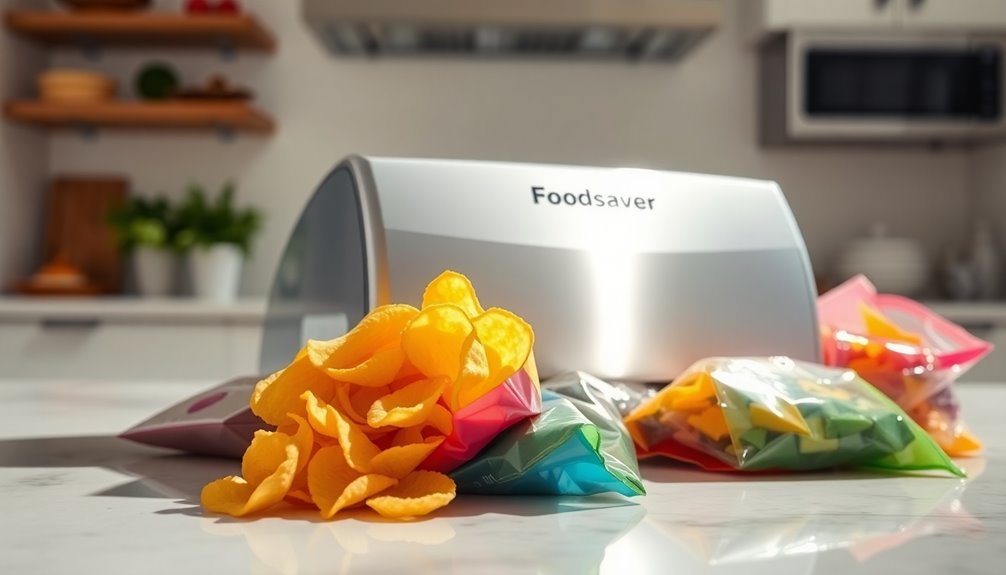
If you want your chips to stay fresh and crunchy, vacuum sealing is the way to go.
By keeping moisture and air at bay, you can prevent them from getting stale and losing that perfect texture.
Plus, with a FoodSaver, you'll enjoy your snacks for much longer while reducing waste.
Preserve Crunchy Texture
While you might enjoy a bag of chips fresh from the store, vacuum sealing them is the best way to preserve their crunchy texture for much longer. This method prevents moisture from entering the bag, greatly extending their shelf life.
Here's how to effectively use your Foodsaver to keep your chips crispy:
- Choose Quality Chips: Start with fresh, high-quality chips. The better the chips, the longer they'll last.
- Use the Right Bags: Opt for vacuum-seal bags designed for snacks. They help maintain that satisfying crunch.
- Seal Properly: Verify the bag is free of air before sealing. The less air in the bag, the less chance of moisture ruining your chips.
- Store in a Cool, Dry Place: After vacuum sealing, keep your chips in a cool area to enhance their longevity.
Prevent Moisture Damage
Keeping your chips fresh longer is all about preventing moisture damage. Using a vacuum sealer is one of the best ways to achieve this. When you vacuum seal your chips, you eliminate air exposure, which greatly extends their shelf life and keeps them crispy for months.
Unlike traditional storage methods, which may only keep chips fresh for a few weeks, vacuum-sealed bags create a strong barrier against the environmental elements that lead to spoilage.
If you've got stale chips, don't toss them out just yet. Vacuum sealing can restore their freshness by removing the air that causes them to lose their crunch. This not only preserves their taste and texture but also makes it easy to prepare snacks in bulk without worrying about them going bad.
For best results, make sure you properly seal the bags to maximize their effectiveness. With a vacuum sealer, you can store your chips with confidence, knowing they'll maintain their original flavor and stay delicious for months.
Control Portion Sizes
Controlling portion sizes is a smart strategy for anyone looking to eat healthier and reduce food waste. With a Foodsaver, you can vacuum seal your meals in portion-sized bags, which prevents overconsumption and guarantees you only thaw what you need.
This method not only cuts down on waste but also supports healthier eating habits.
Here are some tips to help you control portion sizes effectively:
- Plan Your Meals: Before you start, decide on your meals for the week. This helps you determine the right portion sizes.
- Use a Scale or Measuring Cups: Accurately portion out your food to avoid guesswork. This promotes consistent serving sizes.
- Label Your Bags: Write the contents and date on each bag. This makes it easy to grab a meal when you're in a hurry.
- Avoid Impulse Eating: With pre-portioned meals, you're less likely to snack mindlessly, which can lead to healthier eating patterns.
Extend Life of Dry Goods
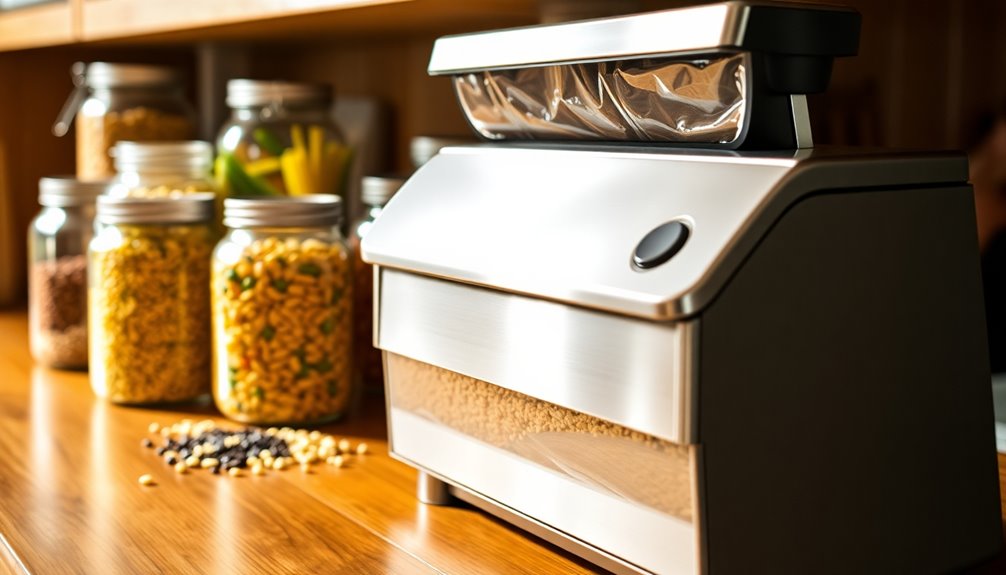
After mastering portion control, it's time to think about how to extend the life of your dry goods. Vacuum sealing is a game changer for items like flour, rice, and nuts. By removing air and sealing out moisture, you can extend shelf life considerably—often keeping these staples fresh for up to six months or longer compared to traditional storage methods.
Not only does vacuum sealing preserve freshness, but it also helps maintain the crunchiness and texture of your dry goods, preventing spoilage and waste. You'll notice a big difference in quality and flavor, and you could save your family an average of $1,500 annually by reducing food waste.
Using vacuum-sealed bags for bulk purchases not only keeps your pantry organized but also encourages mindful consumption, cutting down on those frequent grocery trips.
Plus, properly vacuum-sealed dry goods are less vulnerable to pests and contamination, ensuring safer long-term storage.
Efficient Food Management
When you implement efficient food management practices, you can transform your kitchen and considerably cut down on waste. Using a vacuum sealer can be a game-changer in this process, allowing you to buy in bulk and store food effectively.
Here are four key strategies to enhance your food management:
- Meal Planning: Before shopping, plan your meals to guarantee you only buy what you need. This simple step can save your family over $1,500 a year on spoiled food.
- Portion Control: Use your vacuum sealer to organize foods into portion sizes. This not only saves space but also helps you avoid overeating and promotes mindful consumption.
- Regular Inventory: Conduct regular checks of your vacuum-sealed items. By keeping track of what you have, you can avoid unnecessary purchases and minimize food waste.
- Storage of Dry Goods: Vacuum seal dry goods like flour and rice. This prevents spoilage and extends their shelf life, guaranteeing your bulk buys last longer and reduce your overall grocery costs.
Maximize Your Foodsaver Usage
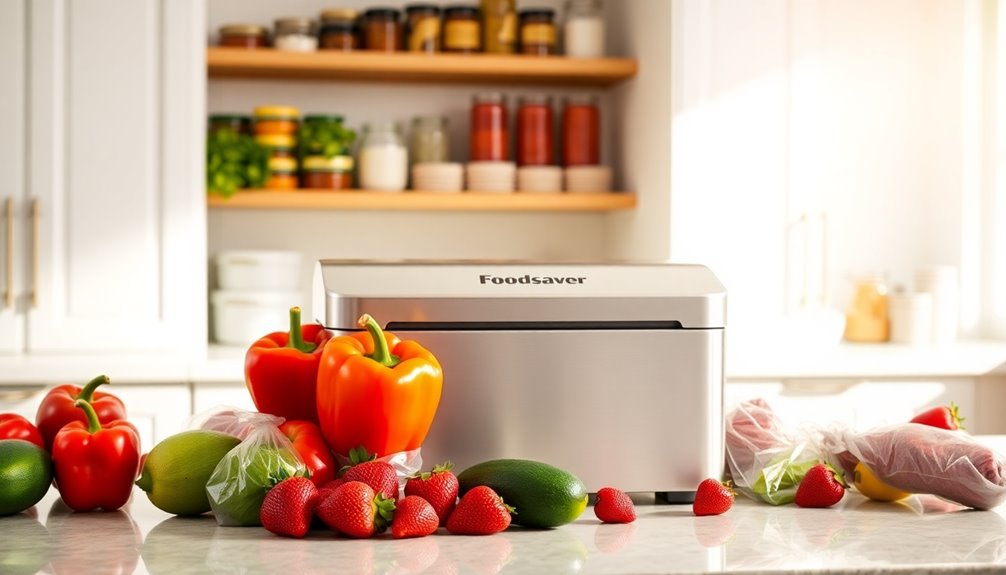
Maximizing your FoodSaver usage can take your food management efforts to the next level. By using a vacuum sealer, you can extend the shelf life of meats and vegetables up to five times longer than traditional storage methods. This not only reduces food waste but also cuts down on your grocery costs.
Consider buying food in bulk and vacuum sealing it in portions. This strategy allows you to take advantage of sales without worrying about spoilage. Always remember to label your vacuum-sealed bags with dates and contents. This helps you keep track of your inventory and guarantees you use items in a timely manner, preventing unnecessary waste.
For moist foods, pre-freezing them before vacuum sealing is crucial. This prevents liquids from being drawn into the machine, assuring a proper seal and maintaining food quality.
Additionally, make it a habit to regularly clean and maintain your FoodSaver vacuum sealer. This simple step guarantees peak performance and can prolong both the life of the appliance and your food supplies.
Implement these tips, and you'll maximize the benefits of your vacuum sealer while saving money and reducing waste.
Conclusion
By using a Foodsaver, you're not just preserving food; you're protecting your pocketbook! With clever conservation techniques, you can cut costs and curb waste while savoring your favorite flavors longer. From sealing snacks to stashing staples, you'll discover delightful ways to extend freshness and fight food spoilage. So, start your savvy storage journey today, and watch your savings soar while enjoying the bountiful benefits of your Foodsaver's fantastic features!

